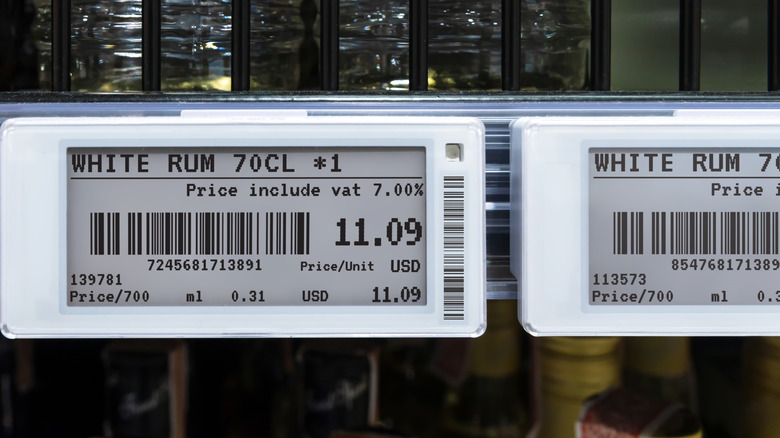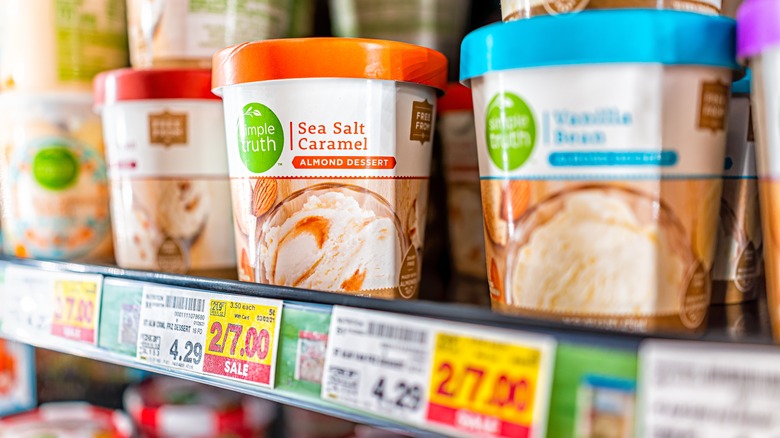How To Read Unit Price Labels At The Grocery Store For Smarter Shopping
If you took all your month's receipts and categorized them by spending type, how much of the pie would your food budget take up? The U.S. Bureau of Labor and Statistics reckons that just over 12% of our spending goes toward food. That's more than we spend on entertainment, apparel, or even healthcare.
Historically, the percentage of disposable income spent on food has decreased since the 1960s. However, the USDA notes a sharp uptick in this percentage since COVID-19. Combine that fact with the reality that over 10% of Americans are food insecure. The bottom line is that food costs and affordability have become significant players in the spending game, especially in the past few years.
The average food budget is split pretty evenly between eating out and eating at home, so your shopping strategy at the local Aldi, Trader Joe's, or another grocery store can help determine how much food you bring home for that half of your budget. And there are many ways to save money on groceries. One of our favorites is checking the unit price label.
How to interpret the unit price
Essentially, the unit price tells you how much the item costs per unit of measurement. It may use increments by weight (grams or pounds), volume (ounces or milliliters), or count (pieces or units). By presenting pricing information separate from marketing ploys or deceiving packaging gimmicks, unit price labels give you a more precise cost comparison, even when package sizes differ.
The food's shelf tag will usually list the product's name, the price for that particular package size, and a barcode for internal inventory. Look closely: the unit price blurb is usually hidden on the bottom corner. If you have a subpar vision, you may want to bring a magnifying glass to the store because that print can be almost microscopic.
Unfortunately, unit price labeling is neither mandatory nor standardized in the U.S., so finding consistent information to compare products can be challenging. For example, one brand of frozen broccoli may list a per-pound breakdown, whereas its neighbor on the shelf may use a per-ounce designation. If the type of measurement is in the same family — in this case, by weight — then you can just convert one unit type to the other. In this example, you would change the pounds to 16 ounces and divide that per-pound number by 16 to achieve a comparable price quote.
The unit price can help you save money
Smarter shopping and saving money go hand in hand. Once you've identified the least expensive grocery stores in your area, that unit price comparison is the next step toward keeping a few more dollars in your pocket. Unless you're a die-hard brand loyalist, let the unit price guide your decision on which brand and package size of the product you buy for that trip.
Let's walk through an example of how this little nugget of information can stretch your dollar. Suppose you pick up two packages of whole wheat spaghetti from different brands. Which is the most cost-effective: brand A at $3.99 for a 2-pound (32-ounce) package or brand B at $1.99 for a 12-ounce package? Let the unit price label do the work for you. Brand A costs $0.12/ounce, whereas brand B costs $0.17/ounce. There's a clear winner, especially since dry pasta is shelf-stable so you can save the unused portion of the package for another meal.
Another strategy involves a general unit price cut-off, like the $1-per-pound rule, to stay true to budget. In this case, you'd buy foods with equivalent per-pound costs that don't exceed $1. Whichever way you leverage per-unit labels, they can streamline your shopping experience and save money.


